The best types and varieties of almonds to grow
Among flowering shrubs, of interest is almond, which, in addition to decorativeness, has useful properties. The value of the plant in nuts, which are eaten, is used for the preparation of medicines. Growing an almond tree on your site is the dream of every summer resident.
Almonds are associated with bliss, the fragrance of the East. In the Middle Ages, traveling with caravans from Asia to the Mediterranean, almonds conquered new territories. Now it is widespread both in Europe and on the American continent as a nut crop. Warmth is important for the tree to grow and is difficult to grow in temperate areas. The plant is successfully cultivated in the south of Russia, in California.
Content:
- Biological features of almonds
- Types of almonds, description of the best varieties
- Reproduction and planting of shrubs
- Plant care recommendations
- About diseases and pests of almonds, the fight against them
- Application of almonds in landscape design
Biological features of almonds
The almond tree belongs to the Rosaceae family, reaching a height of four to six meters. Powerful root system plants are larger than the crown of the tree. The trunk of the almond branches profusely, giving two types of shoots - long and short. The grayish green leaves of the shrub are narrow and long. Before blooming, their almonds bloom. The flowers have white or pink corollas with many stamens. In place of flowers, fruits of a gray-green color are formed, inside the pulp of which there are seeds, or nuts.
When the fruits are ripe, the outside, inedible part of them dries up and is easily separated from the seed.
Oval nuts are two to three centimeters long. Grooves or small dimples are visible on the shell. Depending on the type of almond, the shell has strong walls or is thin, similar to paper. Two types of almond kernels have been identified - bitter and sweet. They differ in both taste and composition. The flesh of the seeds is half fatty oil and 30 percent protein, which indicates the high nutritional value of almonds.
types of nuts are eaten raw, and the oil is used for the preparation of confectionery products. It is used in the perfumery and pharmaceutical industries. The bitter fruits of the tree contain substances useful for the human body. It also possesses valuable qualities and reddish almond wood. Furniture and souvenirs are made from it.
During flowering, almonds attract insects with their scent. Bees collect early nectar flows from the tree, which is especially important for them. And the beauty of the bush, covered with a pink fragrant cloud in early spring, was praised by many poets and artists.
Types of almonds, description of the best varieties
Almonds are grown more often in order to obtain nuts. They are given by common almonds, which have a huge variety of varieties:
- Nikitsky Botanical Garden in the Crimea bred almond varieties Alushtinsky of early ripening, late-ripening Sevastopolsky. They give up to forty kilograms of nuts from one shrub. Their flower buds are resistant to spring frosts.Trees tolerate drought and heat well. The kernels are firm and sweet. The only drawback of varieties is their inability to self-pollinate.
- Victoria belongs to frost-resistant varieties. Already in the fourth year of life, sweetish nuts weighing four to nine grams are harvested from the tree. The shrub is resistant to fungal infections.
- The main difference between the low almond, or steppe almond, is its small height of half - one and a half meters. Large flowers of a rich pink tone appear simultaneously with leaves in May. Shrubs are not afraid of frost, drought tolerant.
- The northern provinces of China are considered the birthplace of the three-lobed almond. The tree blooms in early spring, covered with a thick pink cloud. Each large flower has up to twenty petals, in the middle of them a greenish spot with yellow edges is formed. This type of almond is used in landscape design. The splendor of the plant is combined with the delicacy of the species. He often dies from the cold, does not tolerate drought. Among the popular varieties of ornamental shrubs, Captivity and Joy with double flowers can be distinguished.
- Petiole almonds are found in the steppes of Buryatia. The trunk of a tree reaches a height of no more than a meter. Its elliptical leaves and bright pink flowers adorn the mountain slopes.
All types of almonds are interesting, some for their appearance, some for their useful fruits.
Reproduction and planting of shrubs
Almond propagation takes place in different ways:
- If a bone is taken for planting a tree, then it is very difficult to maintain varietal characteristics. In early spring, a landing site is prepared, protected from the winds. The bone is lowered into a container with sand twenty days before planting and placed in a room with an air temperature of one to ten degrees Celsius. The germinated seeds are ready to be transplanted to a permanent place in the garden. The sprouts are buried in the fertile layer, pinching the roots to stimulate their growth.
- Goes well graft varietal types of almonds for rootstocks of bird cherry, plum. The scion cuttings are grown from a nut or taken from an adult tree. On the branch of the scion, there should be developed eyes, fully formed. Before the procedure, all leaves are removed from the cutting. Reproduction is carried out during the period of active sap flow - in May or August. On the rootstock, a T-shaped incision is made just above the root collar. A cuticle shield is inserted into the hole, pressing with the bark and fixing the inoculation site with tape or plaster.
- For grafting, the material is prepared in the first half of summer by cutting off semi-lignified shoots with two nodes and twenty centimeters long. Cuttings are planted in a nutritious soil mixture, having previously been kept in a growth stimulator.
- After vigorous pruning, almonds produce many young growth. In the second year of life, it is separated along with the root system and transplanted to a permanent place.
- It is similarly propagated by layering. Having bent the side offspring to the ground and fixing it with a hairpin, they weed, loosen, water the ground around. A year later, a root will form at the cut, and you can separate it from the mother bush.
Almond seedlings are planted in a hole thirty centimeters deep. Drainage is laid at the bottom, then sand is poured. Before planting, the root of the seedling is dipped in a clay mash. Having lowered it into the hole, the stem is sprinkled with a substrate of humus, sand. Make sure that the root collar is two centimeters above ground level.
The bush is watered, tied to a support. To preserve moisture, you can mulch the periosteal circle without falling asleep on the basal neck. Almonds are unpretentious in their care, they are not difficult to grow.
Plant care recommendations
For full development, ornamental shrubs need watering... Observing the condition of the soil near the trunk of the plant, the frequency of its moisture is determined. Usually once a week is enough. A bucket of water is poured under each bush. Then the soil around the tree trunk is loosened to a depth of five to ten centimeters.The loosening depth increases with the age of the tree.
The requirements for caring for almonds are simple, it grows successfully not only in warm areas, but also in regions with a temperate climate.
From fertilizers used in feeding almonds mullein, diluting it in a ratio of 1: 6. The mineral complex for almonds consists of ten grams of urea, twenty grams of ammonium nitrate per bucket of water. In the autumn period, twenty grams of superphosphate and potassium sulfate are embedded in each square meter.
The care includes pruning ornamental shrub. In the spring, at the beginning of sap flow, damaged, dried shoots are removed. After the shrub has faded, the formation of the crown is carried out. For rejuvenation, plants remove old branches from an adult tree. Since almonds do not tolerate frosts, especially young shoots, they are covered with straw and material.
About diseases and pests of almonds, the fight against them
Fungal infections often affect almonds. They spread faster if summers are damp:
- Cercosporosis infects trees in early summer. The leaves are covered with a gray bloom, with round reddish spots. The developing pathology leads to drying of the leaves, their falling off.
- Scab fungus spores overwinter in plant debris, becoming more active in spring. At the same time, the growth of young shoots slows down, and the fruits become unsuitable for human consumption. Rust is characterized by the appearance of medium-sized brown spots on the leaves, which merge into one large spot.
- All trees in the garden can become infected with moniliosis if the disease is not controlled. Pathogenic microorganisms overwinter in the remains of vegetation. Symptoms of clasterosporium disease, or perforated spotting, include the appearance of purple spots on the leaves, then on the fruits. Cracks appear on the trunk, gum appears. Spores of the gray mold fungus hide under fluffy islets located on the leaves of almonds.
You can fight fungal diseases by spraying with fungicides such as Topaz, Cuproxat. For the prevention of diseases in the fall, plant waste is removed, burned, and the earth is dug up. Spring treatment with Bordeaux liquid also saves from disease.
Of the pests, they like to feast on the leaves of almond aphids, caterpillars of leaf rollers, spider mites.
To combat aphids, he uses folk remedies. Tincture of pepper is prepared by taking twenty pieces of hot pepper pods in a bucket of water. After keeping the infusion over low heat for an hour, add three hundred grams of laundry soap. After a day of infusion, the bushes are sprayed in the early morning.
Spider mites are destroyed by onion husk infusion, which is prepared by putting onion husks in a bucket and flooding with hot water. After insisting for twelve hours, filter the solution and dilute with water 1: 1. Carrying out timely weeding, loosening the soil will prevent the spread of diseases and pests.
Application of almonds in landscape design
The almond tree can be a decoration for any site. The plant tolerates the conditions of the city well, therefore it is grown in parks, squares, they decorate the entrance to administrative buildings.
Designers use ornamental shrubs in group plantings with red-leaved plant species.
But a lonely tree against the background of a green lawn looks great. Groups of ornamental shrubs are combined with low-growing conifers. Form almonds hedges, giving the original shape to the crown. They use a powerful almond root system to strengthen the slopes, the banks of the reservoir. The early flowering of almonds allows it to be used in conjunction with other ornamental shrubs.
More information can be found in the video:



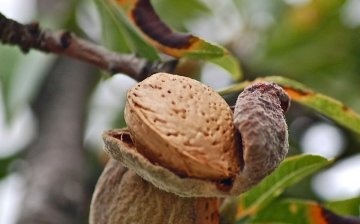
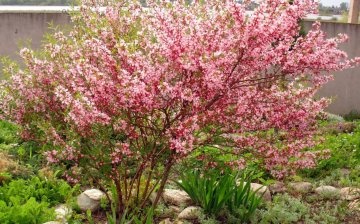
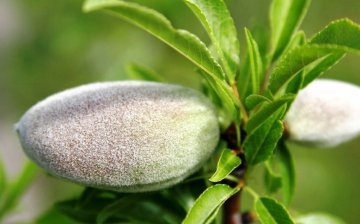
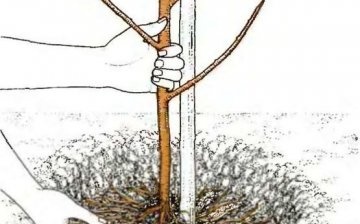
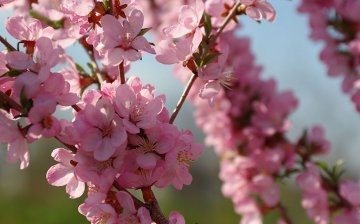
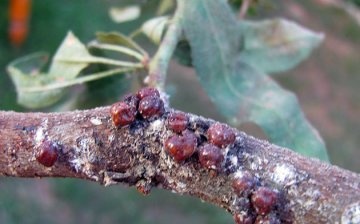
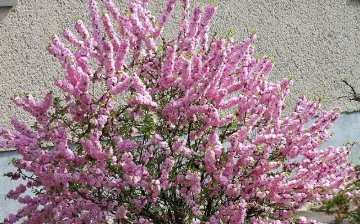







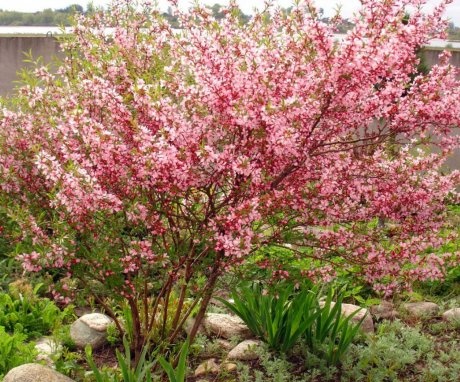
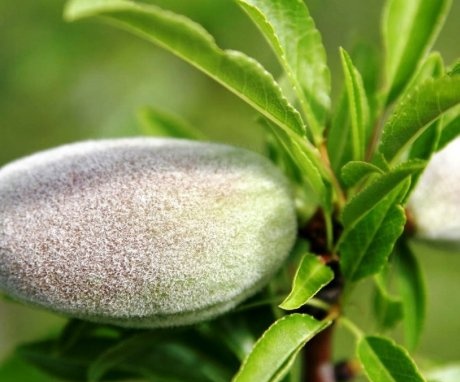
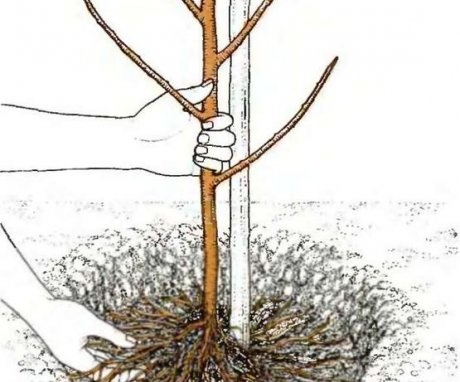
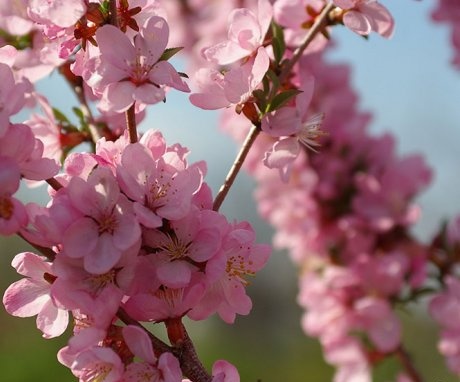
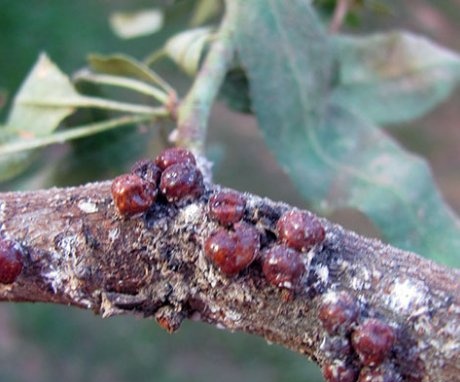
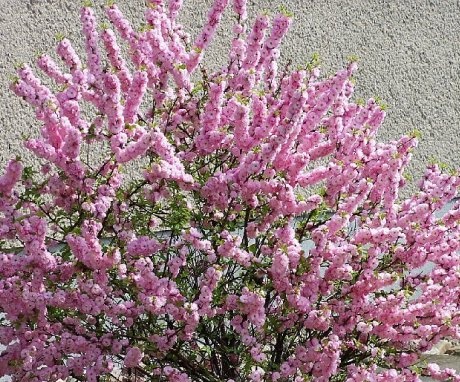
What a beauty all the same, now the almond tree and my dream. I will definitely try to plant such a bush in my country house, guided by the advice from the article.It is important to find a sunny and calm place for him.
A very beautiful shrub. Its flowers are somewhat reminiscent of the Japanese cherry blossoms. And besides, it attracts bees to their summer cottage. And they, in turn, can help in pollination of other summer cottage crops.
Victoria almonds were planted in a summer cottage in the suburbs, but did not take root. Although some plants, such as bush blueberries, grow well and take root. For the winter, just do not forget to cover, like roses.